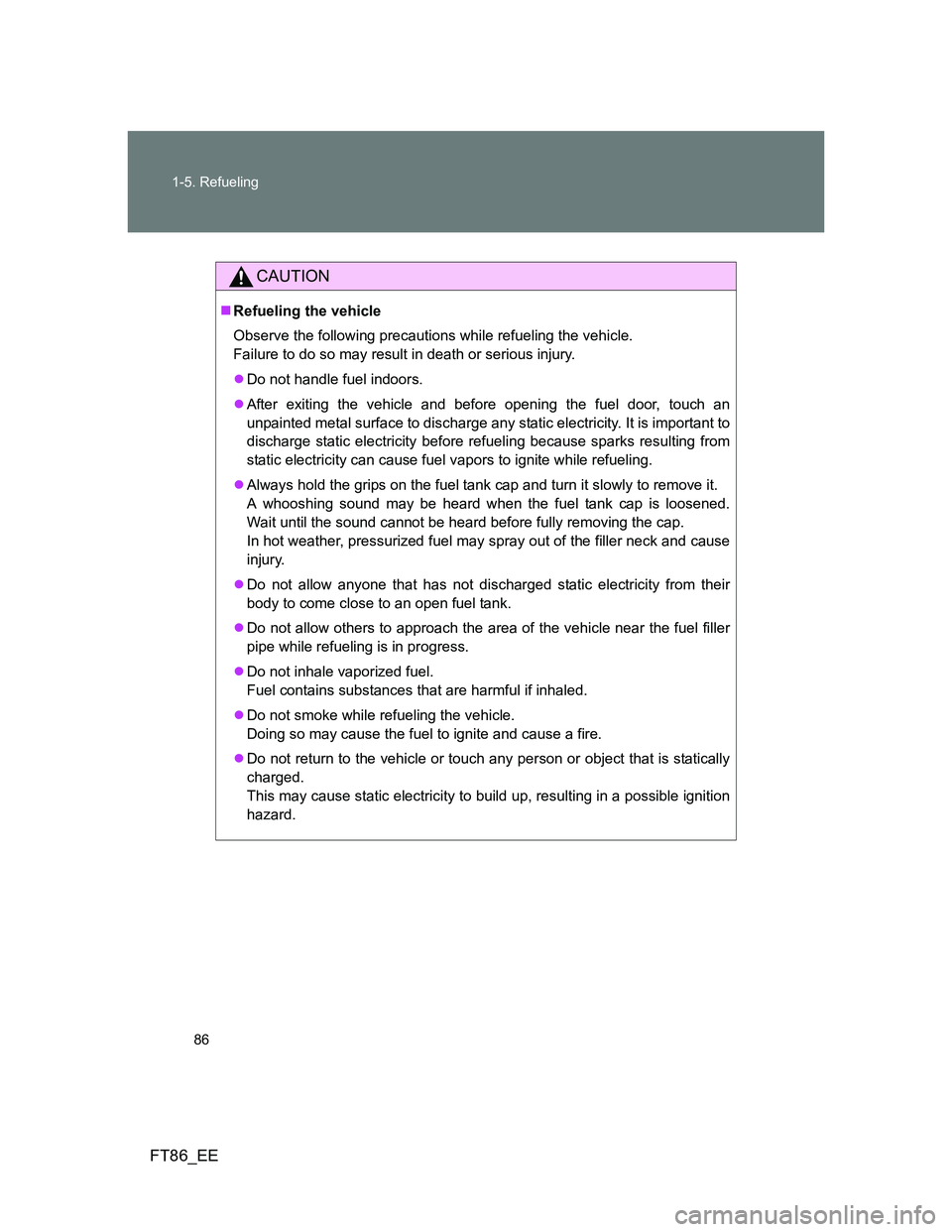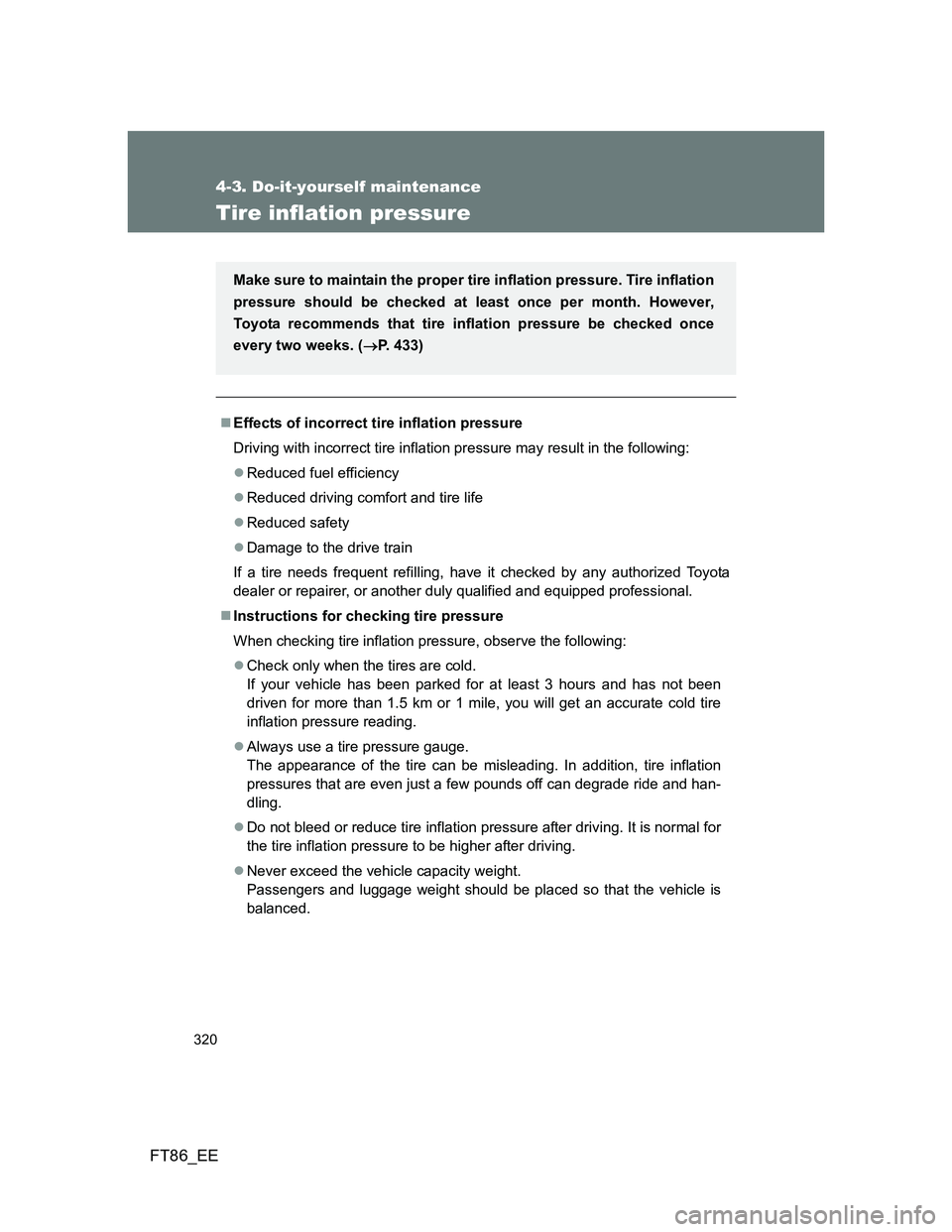Page 2 of 452

TABLE OF CONTENTSIndex
FT86_EE
2
1-1. Key information
Keys ...................................... 28
1-2. Opening, closing and
locking the doors and
trunk
Smart entry & start system ... 31
Wireless remote control ........ 49
Doors .................................... 53
Trunk..................................... 56
1-3. Adjustable components
(seats, mirrors,
steering wheel)
Front seats ............................ 61
Rear seats ............................ 65
Head restraints ..................... 67
Seat belts .............................. 69
Steering wheel ...................... 76
Anti-glare inside rear
view mirror .......................... 77
Outside rear view mirrors...... 78
1-4. Opening and closing
the windows
Power windows ..................... 81
1-5. Refueling
Opening the fuel tank
cap ...................................... 841-6. Theft deterrent system
Engine immobilizer
system................................ 88
Double locking system ......... 97
1-7. Safety information
Correct driving posture ......... 99
SRS airbag (Supplemental
Restraint System
airbag) .............................. 101
Child restraint systems ....... 130
Installing child restraints ..... 138
Airbag manual on-off
system.............................. 153
2-1. Driving procedures
Driving the vehicle .............. 158
Engine (ignition) switch
(vehicles with a smart
entry & start system) ........ 171
Engine (ignition) switch
(vehicles without a smart
entry & start system) ........ 180
Automatic transmission ...... 183
Manual Transmission ......... 190
Turn signal lever................. 193
Parking brake ..................... 194
Horn ................................... 195
1Before driving
2When Driving
Page 27 of 452

1Before driving
27
FT86_EE
1-1. Key information
Keys.................................... 28
1-2. Opening, closing and
locking the doors and
trunk
Smart entry & start
system .............................. 31
Wireless remote control ...... 49
Doors .................................. 53
Trunk .................................. 56
1-3. Adjustable components
(seats, mirrors,
steering wheel)
Front seats.......................... 61
Rear seats .......................... 65
Head restraints ................... 67
Seat belts............................ 69
Steering wheel .................... 76
Anti-glare inside rear
view mirror ........................ 77
Outside rear view
mirrors .............................. 781-4. Opening and closing
the windows
Power windows ................... 81
1-5. Refueling
Opening the fuel tank
cap .................................... 84
1-6. Theft deterrent system
Engine immobilizer
system .............................. 88
Double locking system ........ 97
1-7. Safety information
Correct driving posture ....... 99
SRS airbag
(Supplemental Restraint
System airbag) ............... 101
Child restraint systems ..... 130
Installing child
restraints ......................... 138
Airbag manual on-off
system ............................ 153
Page 84 of 452
84
FT86_EE
1-5. Refueling
Opening the fuel tank cap
Perform the following steps to open the fuel tank cap:
Before refueling the vehicle
Vehicles without a smart entry & start system: Turn the engine
switch off and ensure that all the doors and windows are
closed.
Vehicles with a smart entry & start system: Turn the “ENGINE
START STOP” switch off and ensure that all the doors and
windows are closed.
Confirm the type of fuel. (P. 8 5 )
Opening the fuel tank cap
Pull up the opener to open the
fuel filler door.
Turn the fuel tank cap slowly
to open.
STEP 1
STEP 2
Page 85 of 452
85 1-5. Refueling
1
Before driving
FT86_EE
Closing the fuel tank cap
After refueling, turn the fuel tank
cap until you hear a click. Once
the cap is released, it will turn
slightly in the opposite direction.
Hang the fuel tank cap on the
back of the fuel filler door.STEP 3
Fuel types
EU area:
Unleaded gasoline confirming to European standard EN228, Research
Octane Number of 98 or higher
Except EU area:
Unleaded gasoline, Research Octane Number of 98 or higher
If unleaded gasoline with an octane rating of 98 RON is not available,
unleaded gasoline with an octane rating of 95 RON may be used with no
detriment to engine durability or driveability.
Use of ethanol blended gasoline in a gasoline engine
Toyota allows the use of ethanol blended gasoline where the ethanol content
is up to 10%. Make sure that the ethanol blended gasoline to be used has a
Research Octane Number that follows the above.
Page 86 of 452

86 1-5. Refueling
FT86_EE
CAUTION
Refueling the vehicle
Observe the following precautions while refueling the vehicle.
Failure to do so may result in death or serious injury.
Do not handle fuel indoors.
After exiting the vehicle and before opening the fuel door, touch an
unpainted metal surface to discharge any static electricity. It is important to
discharge static electricity before refueling because sparks resulting from
static electricity can cause fuel vapors to ignite while refueling.
Always hold the grips on the fuel tank cap and turn it slowly to remove it.
A whooshing sound may be heard when the fuel tank cap is loosened.
Wait until the sound cannot be heard before fully removing the cap.
In hot weather, pressurized fuel may spray out of the filler neck and cause
injury.
Do not allow anyone that has not discharged static electricity from their
body to come close to an open fuel tank.
Do not allow others to approach the area of the vehicle near the fuel filler
pipe while refueling is in progress.
Do not inhale vaporized fuel.
Fuel contains substances that are harmful if inhaled.
Do not smoke while refueling the vehicle.
Doing so may cause the fuel to ignite and cause a fire.
Do not return to the vehicle or touch any person or object that is statically
charged.
This may cause static electricity to build up, resulting in a possible ignition
hazard.
Page 87 of 452

87 1-5. Refueling
1
Before driving
FT86_EE
CAUTION
When refueling
Observe the following precautions to prevent fuel overflowing from the fuel
tank:
Securely insert the fuel nozzle into the fuel filler neck.
Stop filling the tank after the fuel nozzle automatically clicks off.
Do not top off the fuel tank.
Observe other precautions that are posted at the service station.
Turn the cap to the right until it clicks to ensure that it is fully tightened. If
the cap is not securely tightened, fuel spillage could occur in the event of
an accident, creating a fire hazard.
When replacing the fuel cap
Do not use anything but a genuine Toyota fuel tank cap designed for your
vehicle. Doing so may cause a fire or other incident which may result in
death or serious injury.
NOTICE
Refueling
Do not spill fuel during refueling.
Doing so may damage the vehicle, such as causing the emission control
system to operate abnormally or damaging fuel system components or the
vehicle's painted surface.
Never add any cleaning agents to the fuel tank. The addition of a cleaning
agent may cause damage to the fuel system.
Immediately put fuel in the tank whenever the low fuel warning light illumi-
nates. Engine misfires as a result of an empty tank could cause damage to
the engine.
Page 234 of 452
234
FT86_EE
2-5. Driving information
Cargo and luggage
CAUTION
Things that must not be carried in the trunk
The following things may cause a fire if loaded in the trunk:
Receptacles containing gasoline
Aerosol cans
Take notice of the following information about storage precautions,
cargo capacity and load:
Stow cargo and luggage in the trunk whenever possible.
Be sure all items are secured in place.
To maintain vehicle balance while driving, position luggage
evenly within the luggage compartment.
For better fuel economy, do not carry unnecessary weight.
Page 320 of 452

320
4-3. Do-it-yourself maintenance
FT86_EE
Tire inflation pressure
Effects of incorrect tire inflation pressure
Driving with incorrect tire inflation pressure may result in the following:
Reduced fuel efficiency
Reduced driving comfort and tire life
Reduced safety
Damage to the drive train
If a tire needs frequent refilling, have it checked by any authorized Toyota
dealer or repairer, or another duly qualified and equipped professional.
Instructions for checking tire pressure
When checking tire inflation pressure, observe the following:
Check only when the tires are cold.
If your vehicle has been parked for at least 3 hours and has not been
driven for more than 1.5 km or 1 mile, you will get an accurate cold tire
inflation pressure reading.
Always use a tire pressure gauge.
The appearance of the tire can be misleading. In addition, tire inflation
pressures that are even just a few pounds off can degrade ride and han-
dling.
Do not bleed or reduce tire inflation pressure after driving. It is normal for
the tire inflation pressure to be higher after driving.
Never exceed the vehicle capacity weight.
Passengers and luggage weight should be placed so that the vehicle is
balanced.
Make sure to maintain the proper tire inflation pressure. Tire inflation
pressure should be checked at least once per month. However,
Toyota recommends that tire inflation pressure be checked once
every two weeks. (P. 433)